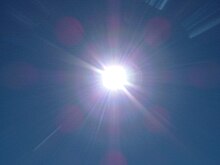
Viewing the Sun through light-concentrating optics such as binoculars may result in permanent damage to the retina without an appropriate filter that blocks UV and substantially dims the sunlight. An attenuating (ND) filter might not filter UV and so is still dangerous. Attenuating filters to view the Sun should be specifically designed for that use: some improvised filters pass UV or IR rays that can harm the eye at high brightness levels. Unfiltered binoculars can deliver over 500 times as much energy to the retina as using the naked eye, killing retinal cells almost instantly. Even brief glances at the midday Sun through unfiltered binoculars can cause permanent blindness.

Partial solar eclipses are hazardous to view because the eye's pupil is not adapted to the unusually high visual contrast: the pupil dilates according to the total amount of light in the field of view, not by the brightest object in the field. During partial eclipses most sunlight is blocked by the Moon passing in front of the Sun, but the uncovered parts of the photosphere have the same surface brightness as during a normal day. In the overall gloom, the pupil expands from ~2 mm to ~6 mm, and each retinal cell exposed to the solar image receives about ten times more light than it would looking at the non-eclipsed Sun. This can damage or kill those cells, resulting in small permanent blind spots for the viewer. The hazard is insidious for inexperienced observers and for children, because there is no perception of pain: it is not immediately obvious that one's vision is being destroyed.
During sunrise and sunset sunlight is attenuated due to Rayleigh scattering and Mie scattering from a particularly long passage through Earth's atmosphere, and the Sun is sometimes faint enough to be viewed comfortably with the naked eye or safely with optics (provided there is no risk of bright sunlight suddenly appearing through a break between clouds). Hazy conditions, atmospheric dust, and high humidity contribute to this atmospheric attenuation.
A rare optical phenomenon may occur shortly after sunset or before sunrise, known as a green flash. The flash is caused by light from the Sun just below the horizon being bent (usually through a temperature inversion) towards the observer. Light of shorter wavelengths (violet, blue, green) is bent more than that of longer wavelengths (yellow, orange, red) but the violet and blue light is scattered more, leaving light that is perceived as green.
Ultraviolet light from the Sun has antiseptic properties and can be used to sanitize tools and water. It also causes sunburn, and has other medical effects such as the production of vitamin D. Ultraviolet light is strongly attenuated by Earth's ozone layer, so that the amount of UV varies greatly with latitude and has been partially responsible for many biological adaptations, including variations in human skin color in different regions of the globe.